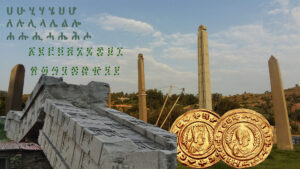Kingdom of Axum (Ge’ez/Tigrigna: መንግስቲ ኣኽሱም), also written as the Kingdom of Aksum or the Aksumite Empire, was an ancient kingdom centered in what is now Eritrea and Tigrai. Axumite rulers were styling themselves as King of kings, king of Aksum, Himyar, Raydan, Saba, Salhen, Tsiyamo, Beja, and of Kush. Ruled by the Aksumites, it existed from approximately 80 BC to 825 AD.
The polity was centered in the city of Axum and grew from the proto-Aksumite Iron Age period around the 4th century BC to achieve prominence by the 1st century AD. Aksum became a major player on the commercial route between the Roman Empire and Ancient India. The Aksumite rulers facilitated trade by minting their own Aksumite currency, with the state establishing its hegemony over the declining Kingdom of Kush. It also regularly entered the politics of the kingdoms on the Arabian Peninsula and eventually extended its rule over the region with the conquest of the Himyarite Kingdom.
The Manichaei prophet Mani (died 274 AD) regarded Axum as one of the four great powers of his time, the others being Persia, Rome, and China.
The Aksumites erected monumental stelae, which served a religious purpose in pre-Christian times. One of these granite columns is the largest such structure in the world, at 90 feet.
Under Ezana (flourished 320–360) Aksum adopted Christianity. In the 7th century, early Muslims from Mecca sought refuge from Quraysh persecution by traveling to the kingdom, a journey known in Islamic history as the First Hijra.
Axum, the kingdom’s ancient capital, is now a town in Tigrai. The Kingdom used the name “Ethiopia” as early as the 4th century. Axum, in its Mariam Tsion Church, is the resting place of the Ark of the Covenant and the home of the Queen of Sheba, during whose reign, unique language and alphabet known as Ge’ez was invented, later to give birth to both Tigrigna and Amharic.

